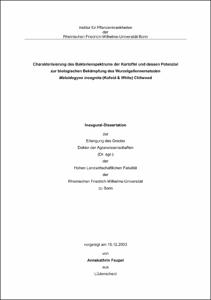Charakterisierung des Bakterienspektrums der Kartoffel und dessen Potenzial zur biologischen Bekämpfung des Wurzelgallennematoden Meloidogyne incognita (Kofoid & White) Chitwood

Charakterisierung des Bakterienspektrums der Kartoffel und dessen Potenzial zur biologischen Bekämpfung des Wurzelgallennematoden Meloidogyne incognita (Kofoid & White) Chitwood

| dc.contributor.advisor | Sikora, Richard A. | |
| dc.contributor.author | Faupel, Annekathrin | |
| dc.date.accessioned | 2020-04-06T08:15:19Z | |
| dc.date.available | 2020-04-06T08:15:19Z | |
| dc.date.issued | 2004 | |
| dc.identifier.uri | https://hdl.handle.net/20.500.11811/1875 | |
| dc.description.abstract | Pflanzenassoziierte Bakterien können zum Pflanzenwachstum und zur Pflanzengesundheit beitragen, jedoch ist bisher wenig über ihre Abundanz, Diversität und ihr antagonistisches Potenzial zur biologischen Kontrolle bodenbürtiger Schaderreger bekannt. Von Kartoffelpflanzen der Sorte 'CILENA' wurden insgesamt 2716 Bakterienisolate aus den Mikrohabitaten Rhizosphäre/Endorhiza und Phyllosphäre/Endosphäre isoliert und mittels FAME-Gaschromatographie identifiziert. Diese Daten wurden zur Berechnung des Artenreichtums (R1), der Diversität (N1, N2) und der Evenness (E5) verwendet, um die Populationsspektren in bezug auf Habitat und Vegetationsstadium vergleichen zu können. Es zeigten sich Unterschiede in der Zusammensetzung der Bakterienpopulationen und der Diversitäten in den einzelnen Habitaten und deutliche Veränderungen im Laufe der Vegetationsperiode. Die Gattungen Bacillus und Pseudomonas zeigten generell die höchste Dominanz. In der Rhizosphäre waren daneben noch die Gattungen Arthrobacter, Sphingobacterium und Stenotrophomonas, in der Endorhiza Agrobacterium und Stenotrophomonas und in der Phyllosphäre die Gattung Arthrobacter dominant vertreten. In der Endosphäre waren neben Bacillus und Pseudomonas überwiegend die Gattungen Agrobacterium, Curtobacterium und Micrococcus zu finden. Alle Isolate wurden einem Dualkulturtest auf antagonistische Aktivität gegen die bodenbürtigen Schaderreger Verticillium dahliae und Rhizoctonia solani unterzogen. Dabei zeigten 14-15 % der Isolate vor allem zum Stadium der Blüte in der Rhizosphäre und Endorhiza antagonistische Aktivität. Bis zu 88 % dieser Bakterien waren den dominanten Gattungen Bacillus und Pseudomonas zugehörig. Neben der antagonistischen Aktivität gegenüber den bodenbürtigen Pilzen wurden 156 Bakterienisolate zusätzlich auf ihr antagonistisches Potenzial gegen den Wurzelgallennematoden M. incognita an Kartoffelpflanzen getestet. Siebenundvierzig Isolate zeigten dabei eine Reduktion der Anzahl der Gallen und Eiermassen von über 25 %. Die Bakterienisolate stammten überwiegend aus den Gattungen Pseudomonas (47 %), Streptomyces (15 %) und Paenibacillus (12 %). Die besten Isolate mit Wirkung gegen mehrere Schaderreger waren Streptomyces violaceusniger RR76 und Pseudomonas putida 3R2-12 aus der Rhizosphäre. Sie führten zu einer Reduktion der Gallen von M. incognita von mehr als 50 % und einer starken Hemmung des Wachstums von V. dahliae und R. solani. Diese Isolate könnten potenzielle Kanditaten für die Entwicklung biologischer Präparate zur Pathogenkontrolle darstellen. | en |
| dc.description.abstract | Characterization of potato-associated bacteria and their potential for the biological control of the root-knot nematode Meloidogyne incognita (Kofoid & White) Chitwood Plant associated bacteria are able to improve plant growth and health but little is known about their diversity, abundance and antagonistic potential for the biological control of soilborne pathogens. Samples of roots and leaves of potato plants var. 'CILENA' were taken at three different growth stages (establishment, flowering, maturity) and 2716 bacteria were isolated from the microhabitats rhizosphere/endorhiza and phyllosphere/endosphere. The isolates were characterized using FAME gas chromatography. Data obtained were used for calculation of richness (R1) and diversity (N1, N2) and evenness (E5) to compare population spectra between habitats and growth stages of the potato plant. Composition and diversity of bacterial populations changed significantly over time in all habitats. In general Bacillus and Pseudomonas were the most dominant genera. Further dominant genera were Stenotrophomonas in the rhizosphere and endorhiza, Arthrobacter in the phyllosphere and Agrobacterium, Curtobacterium and Micrococcus in the endosphere. Bacterial isolates were then tested for their antagonistic potential against the soilborne pathogens Verticillium dahliae and Rhizoctonia solani in vitro. The highest antagonistic activity with 14-15 % of all isolates occurred in the rhizosphere and endorhiza at flowering. Eighty eight percent of this antagonistic bacteria belonged to the genera Pseudomonas and Bacillus. A total of 156 antagonistic bacteria were screened against Meloidogyne incognita on potato in the greenhouse. Forty seven bacterial isolates reduced the number of galls and egg masses for more than 25 %. Bacterial isolates effective against M. incognita predominantly belonged to the genera Pseudomonas (47 %), Streptomyces (15 %) and Paenibacillus (12 %). The best isolates with multiple effects against all the three pathogens were Streptomyces violaceusniger RR76 and Pseudomonas putida 3R2-12 originally isolated from the rhizosphere. Both isolates reduced the number of galls caused by M. incognita for more than 50 % and caused a strong growth inhibition of V. dahliae and R. solani and might be potential candidates for the development of new biocontrol agents against these soilborne pathogens. | en |
| dc.language.iso | deu | |
| dc.rights | In Copyright | |
| dc.rights.uri | http://rightsstatements.org/vocab/InC/1.0/ | |
| dc.subject | endophatische Bakterien | |
| dc.subject | Kartoffel | |
| dc.subject | FAME | |
| dc.subject | biologische Bekämpfung | |
| dc.subject | Diversität | |
| dc.subject | Nematoden | |
| dc.subject.ddc | 570 Biowissenschaften, Biologie | |
| dc.subject.ddc | 580 Pflanzen (Botanik) | |
| dc.subject.ddc | 630 Landwirtschaft, Veterinärmedizin | |
| dc.title | Charakterisierung des Bakterienspektrums der Kartoffel und dessen Potenzial zur biologischen Bekämpfung des Wurzelgallennematoden Meloidogyne incognita (Kofoid & White) Chitwood | |
| dc.type | Dissertation oder Habilitation | |
| dc.publisher.name | Universitäts- und Landesbibliothek Bonn | |
| dc.publisher.location | Bonn | |
| dc.rights.accessRights | openAccess | |
| dc.identifier.urn | https://nbn-resolving.org/urn:nbn:de:hbz:5n-03235 | |
| ulbbn.pubtype | Erstveröffentlichung | |
| ulbbnediss.affiliation.name | Rheinische Friedrich-Wilhelms-Universität Bonn | |
| ulbbnediss.affiliation.location | Bonn | |
| ulbbnediss.thesis.level | Dissertation | |
| ulbbnediss.dissID | 323 | |
| ulbbnediss.date.accepted | 13.02.2004 | |
| ulbbnediss.institute | Landwirtschaftliche Fakultät : Institut für Pflanzenkrankheiten | |
| ulbbnediss.fakultaet | Landwirtschaftliche Fakultät | |
| dc.contributor.coReferee | Goldbach, Heiner E. |
Files in this item
This item appears in the following Collection(s)
-
E-Dissertationen (1103)




